
Aml10 Amoxycillin
RM0.00Brand:
Thermo ScientificTM OxoidTM

Aml2 Amoxycillin
RM0.00Brand:
Thermo ScientificTM OxoidTM

Aml25 Amoxycillin
RM0.00Brand:
Thermo ScientificTM OxoidTM

Amoxycillin 256 M.I.C.E. (10 Pack)
RM0.00Brand:
Thermo ScientificTM OxoidTM
**This product is not available at the moment.
Effortlessly establish accurate Minimum Inhibitory Concentration (MIC) values manually using Thermo Scientific™ Oxoid™ Amoxycillin M.I.C.Evaluator Strips (M.I.C.E.™).

Amoxycillin 256 M.I.C.E. (50 Pack)
RM0.00Brand:
Thermo ScientificTM OxoidTM
**This product is not available at the moment.
Effortlessly establish accurate Minimum Inhibitory Concentration (MIC) values manually using Thermo Scientific™ Oxoid™ Amoxycillin M.I.C.Evaluator Strips (M.I.C.E.™).

Amoxycillin/Clavulanic Acid 256 M.I.C.E. 10pk
RM0.00Brand:
Thermo ScientificTM OxoidTM
**This product is not available at the moment.
Effortlessly establish accurate Minimum Inhibitory Concentration (MIC) values manually using Thermo Scientific™ Oxoid™ Amoxycillin/ Clavulanic acid M.I.C.Evaluator Strips (M.I.C.E.™).

Amoxycillin/Clavulanic Acid 256 M.I.C.E. 50pk
RM0.00Brand:
Thermo ScientificTM OxoidTM
**This product is not available at the moment.
Effortlessly establish accurate Minimum Inhibitory Concentration (MIC) values manually using Thermo Scientific™ Oxoid™ Amoxycillin/ Clavulanic acid M.I.C.Evaluator Strips (M.I.C.E.™).

Amp10 Ampicillin
RM77.00Brand:
Thermo ScientificTM OxoidTM
Manually determine the antibiotic susceptibility of microorganisms using Antimicrobial Susceptibility Testing (AST) methods in conjunction with reliable, easy-to-use Thermo Scientific™ Oxoid™ Ampicillin Antimicrobial Susceptibility Disks.

Amp2 Ampicillin
RM83.00Brand:
Thermo ScientificTM OxoidTM

Amp25 Ampicillin
RM0.00Brand:
Thermo ScientificTM OxoidTM
** This item is not available at the moment. Please contact us for more information.
Manually determine the antibiotic susceptibility of microorganisms using Antimicrobial Susceptibility Testing (AST) methods in conjunction with reliable, easy-to-use Thermo Scientific™ Oxoid™ Ampicillin Antimicrobial Susceptibility Disks.

Ampicillin 256 M.I.C.E. (10 Pack)
RM0.00Brand:
Thermo ScientificTM OxoidTM
**This product is not available at the moment.
Effortlessly establish accurate Minimum Inhibitory Concentration (MIC) values manually using Thermo Scientific™ Oxoid™ Ampicillin M.I.C.Evaluator Strips (M.I.C.E.™).

Ampicillin 256 M.I.C.E. (50 Pack)
RM0.00Brand:
Thermo ScientificTM OxoidTM
**This product is not available at the moment.
Effortlessly establish accurate Minimum Inhibitory Concentration (MIC) values manually using Thermo Scientific™ Oxoid™ Ampicillin M.I.C.Evaluator Strips (M.I.C.E.™).
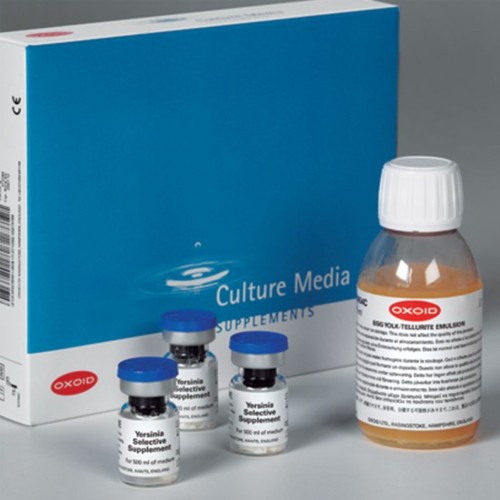
Ampicillin Selective Supplement 1 x 10 Vials
RM479.00Brand:
Thermo ScientificTM OxoidTM
- Oxoid Ampicillin Selective Supplement is used for the isolation of Aeromonas hydrophila.
- Add to to Aeromonas Medium Base, Part No. CM0833B.
Ampicillin Selective Supplement, Oxoid Preparation:
Suspend 29.5g in 500ml of distilled water. Bring gently to the boil. DO NOT AUTOCLAVE. Cool to 50°C and aseptically add one vial of Ampicillin Selective Supplement SR0136 reconsituted as directed. Mix well and pour plates.
| Vial contents (each vial is sufficient for 500 ml of medium) | per vial | per litre |
| Ampicillin | 2.5mg | 5.0mg |
Storage conditions and Shelf life
Store the dehydrated medium at 10-30°C and use before the expiry date on the label.
Store the prepared plates of medium 2-8°C.
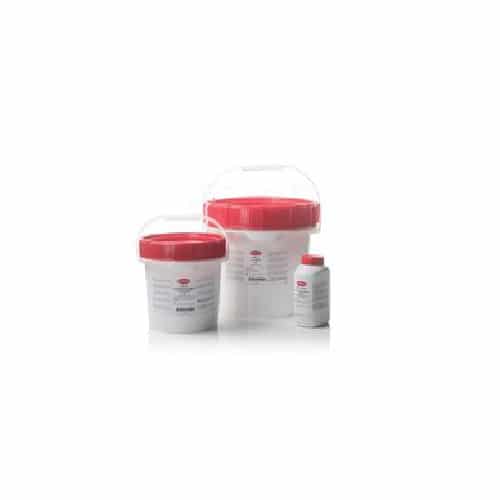
Anaerobe Basal Agar 500g
RM715.00Brand:
Thermo ScientificTM OxoidTM
- Oxoid Anaerobe Basal Agar is used for growth of fastidious and other anaerobes.
- Also available N-S Anaerobe Selective Supplement, Part No. SR0107B, for use for nonsporforming anaerobes and G-N Anaerobe Selective Supplement, Part No. SR0108B, for use for gram-negative anaerobes.
Anaerobe Basal Agar, Oxoid Composition
| Typical Formula * | gm/litre |
| Peptone | 16.0 |
| Yeast extract | 7.0 |
| Sodium chloride | 5.0 |
| Starch | 1.0 |
| Dextrose | 1.0 |
| Sodium pyruvate | 1.0 |
| Arginine | 1.0 |
| Sodium succinate | 0.5 |
| L-cysteine HCl | 0.25 |
| Sodium bicarbonate | 0.4 |
| Ferric pyrophosphate | 0.5 |
| Haemin | 0.005 |
| Vitamin K | 0.0005 |
| Dithiothreitol | 0.25 |
| Agar | 12.0 |
| pH 6.8 ± 0.2 @ 25°C |
Anaerobe Basal Agar, Oxoid Preparation:
Suspend 46g in 1 litre of distilled water. Sterilise by autoclaving at 121°C for 15 minutes. Cool to 50-55°C and aseptically add 5-10% sterile Defibrinated Horse Blood SR0050.
Storage conditions and Shelf life
Store the dehydrated medium at 10-30°C and use before the expiry date on the label.
Store the prepared plates of medium for upto 3 weeks at 2-8°C.

Anaerobe Basal Broth 500g
RM2,615.00Brand:
Thermo ScientificTM OxoidTM
Cultivate anaerobic microorganisms, particularly Bacteroides spp. and other fastidious anaerobes with Thermo Scientific™ Oxoid™ Anaerobe Basal Agar (Dehydrated). Anaerobe Basal Broth is formulated from a range of nutrients which have been selected to optimize the recovery and growth of the majority of anaerobic organisms of clinical importance.
Anaerobe Basal Broth, Oxoid Composition
| Typical Formula * | gm/litre |
| Peptone | 16.0 |
| Yeast extract | 7.0 |
| Sodium chloride | 5.0 |
| Starch | 1.0 |
| Dextrose | 1.0 |
| Sodium pyruvate | 1.0 |
| Arginine | 1.0 |
| Sodium succinate | 0.5 |
| L-cysteine HCl | 0.25 |
| Sodium bicarbonate | 0.4 |
| Ferric pyrophosphate | 0.5 |
| Haemin | 0.005 |
| Vitamin K | 0.0005 |
| Dithiothreitol | 0.25 |
| Agar | 12.0 |
| pH 6.8 ± 0.2 @ 25°C |
Anaerobe Basal Broth, Oxoid Preparation:
Suspend 35.4g of Anaerobe Basal Broth in 1 litre of distilled water. Bring to the boil to dissolve. Distribute into final containers. Sterilise by autoclaving at 121°C for 15 minutes.
Storage conditions and Shelf life
Anaerobe Basal Broth should be stored tightly capped in the original container at 10-30°C. When stored as directed, the medium will remain stable until the expiry date printed on the label.
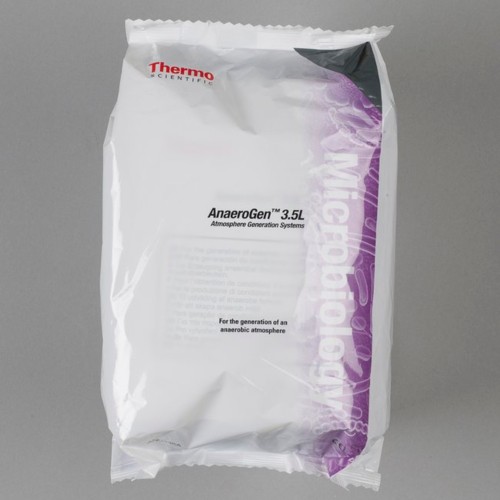
Anaerogen 3.5L (10 Pack)
RM165.00Brand:
Thermo ScientificTM OxoidTM
Thermo Scientific™ Oxoid AnaeroGen 3.5L Sachet is anaerobic gas generating sachets, that can produce 3.5L of anaerobic system. The anaerobic condition can be determined using Anaerobic Indicator. Once the anaerobic condition is generated, it is suitable to grow anaerobes, which favour carbon dioxide.
Features of Oxoid AnaeroGen
- No water or catalyst required
- No hydrogen gas produced

Anaerogen Compact 10 Pack
RM189.00Brand:
Thermo ScientificTM OxoidTM
Thermo Scientific™ Oxoid™ AnaeroGen™ Compact Sachet is a simple anaerobic gas generator system for the anaerobic incubation of up to four petri dishes or an identification panel.
- Use one sachet / Compact Plastic Pouch
- Use with Compact Plastic Pouch, Part No. AG0020C and AnaeroGen Compact Sealing Clip, Part No. AN0005C
Includes : 10 sachets.
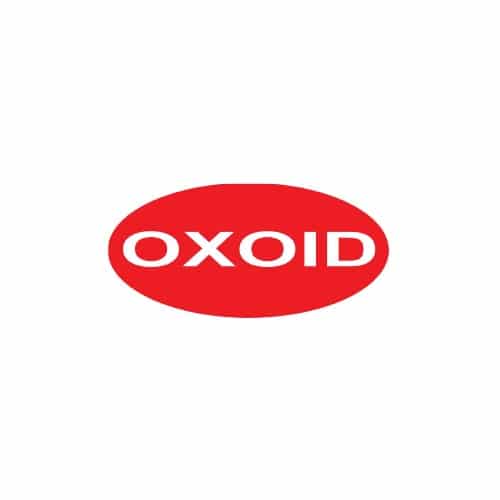
Anaerogen W-Zip Compact
RM287.00Brand:
Thermo ScientificTM OxoidTM
Oxoid AnaeroGen W-Zip Compact is a simple anaerobic gas generator system for the anaerobic incubation of up to four petri dishes or an identification panel.
- Use 1 sachet / Compact Plastic Pouch
Includes : 10 sachets and 10 W-Zip pouches.
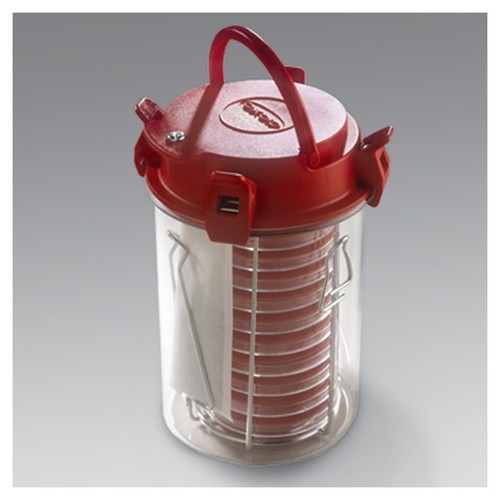
AnaeroJar 2.5L Jar (Full Assembly), Oxoid
RM1,257.00Brand:
Thermo ScientificTM OxoidTM
Oxoid AnaeroJar 2.5L Jar is an anaerobic jar that comes complete with 2.5L capacity polycarbonate jar base and lid secured to the base by four self-venting clips.
Features of AnaeroJar 2.5L Jar, Oxoid
1 Lid incorporates carrying handle and vacuum release feature
2 Plate carrier included
3 Jar holds up to 12 plates
4 No catalyst required

Anaerojar Base, Oxoid
RM1,300.00Brand:
Thermo ScientificTM OxoidTM
Oxoid AnaeroJar Base is a polycarbonate jar base for use with AnaeroJar 2.5L, Part No. AG0025A.

Anaerojar Clips
RM239.00Brand:
Thermo ScientificTM OxoidTM
Oxoid AnaeroJar Clip has two self-venting clips. For use with AnaeroJar 2.5L, Part No. AG0025A.
Includes :
2 self-venting clips.

Anaerojar Lid
RM449.00Brand:
Thermo ScientificTM OxoidTM
Oxoid AnaeroJar Lid is for use with AnaeroJar 2.5L, Part No. AG0025A.

Anaerojar O Ring
RM187.00Brand:
Thermo ScientificTM OxoidTM
Oxoid AnaeroJar O-Ring is for use with AnaeroJar 2.5L, Part No. AG0025A.

Andrades Peptone Water 500g
RM430.00Brand:
Thermo ScientificTM OxoidTM
This product has been discontinued. The alternative to this product is Peptone Water.
Oxoid Peptone Water Andrade’s is a nutrient base containing Andrade’s indicator to which carbohydrates and other diagnostic reagents may be added for use in fermentation studies.
Peptone Water Andrade’s, Oxoid Composition
| Typical Formula * | gm/litre |
| Peptone | 10.0 |
| Sodium chloride | 5.0 |
| Andrade’s Indicator (acid-Fuchsin) | 0.1 |
| pH 7.4 ± 0.2 @ 25°C |
Peptone Water Andrade’s, Oxoid Preparation:
Suspend 15 g in 1 litre of distilled water. Mix well to dissolve, distribute into tubes or bottles, containing Durham tubes and sterilize by autoclaving at 121°C for 15 minutes.
Storage conditions and Shelf life
Store the dehydrated medium at 10-30°C and use before the expiry date on the label.
Store the prepared medium in the dark at room temperature.



